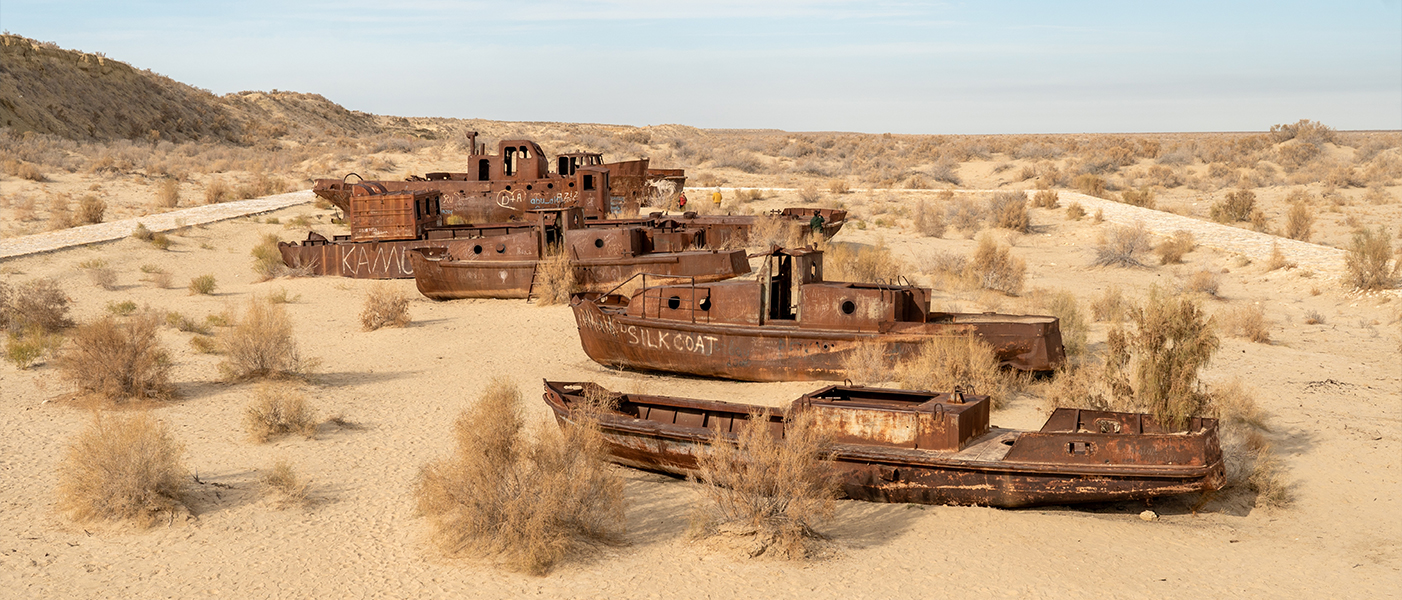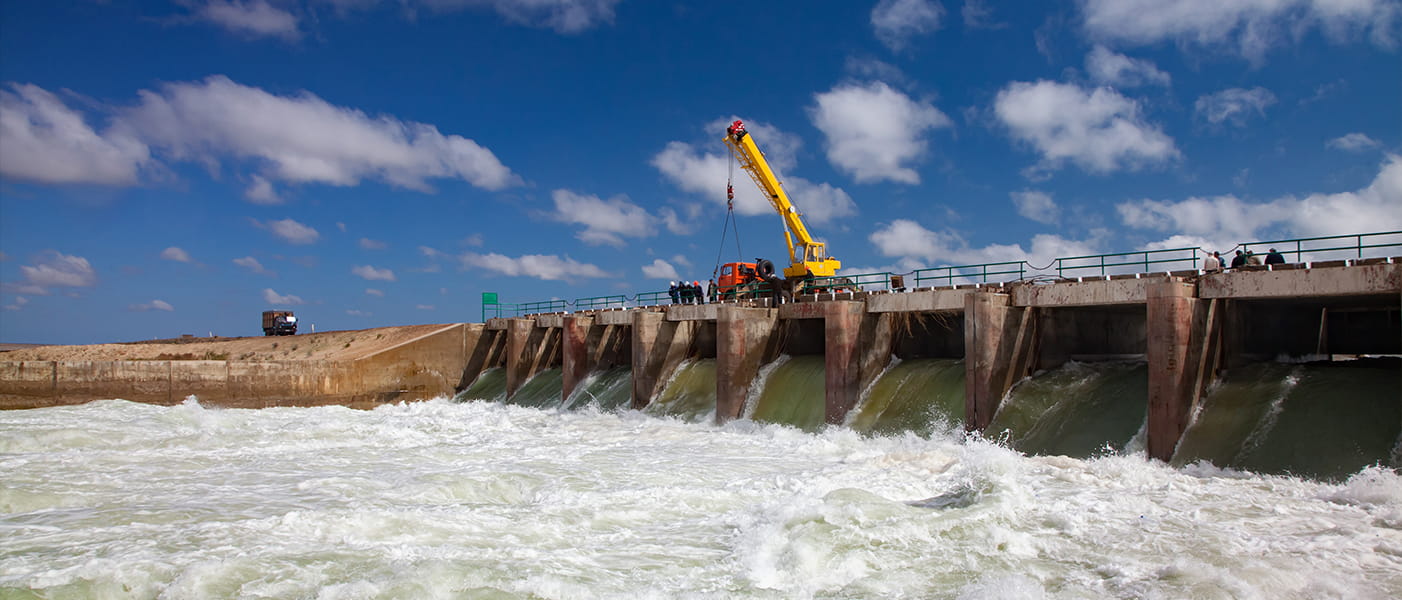Read the latest thoughts and analysis on breakthrough solutions driving impact for a sustainable future
Lessons from the Aral Sea: from desolation to revival
As COP29 organizers in Azerbaijan prepare to host world leaders for high-stakes climate negotiations, across the Caspian Sea two Central Asian nations are working together to address an ecological crisis.
The Aral Sea, straddling the borders of Kazakhstan and Uzbekistan, was the world’s fourth largest lake in 1960. But in only six decades it has shrunk to just 10% of its former size. Fish and bird populations have collapsed. Local people endure ever harsher weather, difficulties growing crops, and debilitating health conditions brought on by a rapidly changing climate. The disappearance of this vast body of water and its catastrophic environmental and socioeconomic impacts on the region is an alarming allegory for the climate crisis at the global level.
But there's hope. Recent progress in water management, both in the region and elsewhere, may help the Aral Sea recover, and teach us critical lessons about safeguarding our natural resources.
Unprecedented decline
The decline of the Aral Sea has happened over just one lifetime.
Local people have fond memories of swimming in its waters. It boasted a thriving fishing industry. That all changed in 1959, when the Soviet Union brought industrialized cotton production to the region.
A water-intensive crop, cotton was grown using extremely inefficient irrigation practices which diverted water from the Aral’s tributaries. Some of these waterways lost half their volume, and were polluted with fertilizers and harmful pesticides. By 2007, the lake had dropped to just 10% of its original size, and salinity had risen from 14 grams per liter to over 100 – around three times that of normal seawater.
Once thriving lakeside towns and villages found themselves in the middle of a desert, their fishing boats half-buried and rusting in the sand.
The retreat of the lake also exposed 54,000 km2 of salt and dust, contaminated with pesticides, which is now blown across the region by increasingly strong winds. This causes a wide range of debilitating health conditions among humans, including kidney failure, anemia and intestinal cancer. Respiratory conditions affect children up to 200 kilometers away.
Restoring the Aral Sea was seen by many as a lost cause. And major challenges remain - from continued reliance on outdated cotton-farming practices, to regional tensions over how to share the water of the lake and its tributaries. But investment in infrastructure and the resilience of local communities have begun to pull it back from the brink.

Reviving the Aral
The completion of the Kokaral Dam in 2005, financed by the World Bank, was a vital turning point, offering the Aral Sea hope at its lowest ebb. The dam has led to an 18% increase in the volume of the northern part of the lake in Kazakhstan. Several fish species now thrive, as do the fishermen: Within ten years, their annual catch grew fivefold. A second World-Bank-financed dam nearby is set to continue the transformation of the local ecosystem and bring the entire reservoir’s temperature and salinity levels closer to 1960 levels, encouraging biodiversity.
Across the border in Uzbekistan, mass planting of saxaul shrubs is underway, in partnership with USAID. In just four years, these robust plants, which act as the first line of defense against desertification, have helped restore over half of the country’s three million hectares of degraded land.
Encouragingly, these measures are being matched by impactful water management reforms and investment at the governmental level. Uzbekistan is reconstructing irrigation networks, modernizing water management systems and introducing drought-resistant crops. Farming subsidies for water-saving agricultural technologies could reduce consumption by 40-50% and mineral fertilizers by 25-30%. The impact has already been immense. From just 28,000 hectares of farmland in 2018, these technologies now cover 1 million hectares - representing 27 percent of the total irrigated area. The government intends to double this by the end of 2025.
International collaboration
These country initiatives feed into the efforts of the International Fund for Saving the Aral Sea (IFAS), founded 30 years ago by the five nations of Central Asia. A unique collaborative effort, the fund is the most important platform for regional cooperation, encouraging member states to work together to share transboundary water and address the environmental and socio-economic problems of the Aral Sea basin. Kazakhstan is hoping to use its chairmanship of the fund to formalize an agreement to regulate the flow of the Syr Darya, one of the Aral’s main tributaries, helping avoid droughts in downstream countries.
In addition, the UN-backed Multi-Partner Human Security Trust Fund for the Aral Sea Region aims to channel financing into innovative solutions for this complex challenge. In 2021, the UN General Assembly declared the Aral Sea region a 'zone of environmental innovations and technologies', to encourage international research and scientific collaboration in the area.
It is unlikely that the Aral Sea will ever return to its 1960 level, but recent progress has handed this struggling waterway a vital lifeline. The sea’s rapid bounce back over just two decades shows the vast potential of water management measures, for the local ecosystem and the people whose livelihoods depend on it.

Hope for the future
The plight of the Aral Sea is an alarming glimpse into the planet’s future if we do not manage our precious natural resources responsibly. The lessons we can draw from both its destruction and revival apply everywhere.
Rivers, lakes and seas are a vital lifeline that billions depend on for food, livelihoods and power. Their steward governments have a responsibility to work together to share the benefits fairly and sustainably. That means supporting farmers with efficient water infrastructure and providing the right incentives to help them switch to more sustainable crops and practices. It means working collaboratively to ensure a regular flow from source to sea to stabilize regional climates.
While water management may not be taking center stage at COP29, it is critical to the wider goals of the Paris Agreement. It might just bring our struggling waterways back to life.
The Aral Sea, straddling the borders of Kazakhstan and Uzbekistan, was the world’s fourth largest lake in 1960. But in only six decades it has shrunk to just 10% of its former size. Fish and bird populations have collapsed. Local people endure ever harsher weather, difficulties growing crops, and debilitating health conditions brought on by a rapidly changing climate. The disappearance of this vast body of water and its catastrophic environmental and socioeconomic impacts on the region is an alarming allegory for the climate crisis at the global level.
But there's hope. Recent progress in water management, both in the region and elsewhere, may help the Aral Sea recover, and teach us critical lessons about safeguarding our natural resources.
Unprecedented decline
The decline of the Aral Sea has happened over just one lifetime.
Local people have fond memories of swimming in its waters. It boasted a thriving fishing industry. That all changed in 1959, when the Soviet Union brought industrialized cotton production to the region.
A water-intensive crop, cotton was grown using extremely inefficient irrigation practices which diverted water from the Aral’s tributaries. Some of these waterways lost half their volume, and were polluted with fertilizers and harmful pesticides. By 2007, the lake had dropped to just 10% of its original size, and salinity had risen from 14 grams per liter to over 100 – around three times that of normal seawater.
Once thriving lakeside towns and villages found themselves in the middle of a desert, their fishing boats half-buried and rusting in the sand.
The retreat of the lake also exposed 54,000 km2 of salt and dust, contaminated with pesticides, which is now blown across the region by increasingly strong winds. This causes a wide range of debilitating health conditions among humans, including kidney failure, anemia and intestinal cancer. Respiratory conditions affect children up to 200 kilometers away.
Restoring the Aral Sea was seen by many as a lost cause. And major challenges remain - from continued reliance on outdated cotton-farming practices, to regional tensions over how to share the water of the lake and its tributaries. But investment in infrastructure and the resilience of local communities have begun to pull it back from the brink.

Reviving the Aral
The completion of the Kokaral Dam in 2005, financed by the World Bank, was a vital turning point, offering the Aral Sea hope at its lowest ebb. The dam has led to an 18% increase in the volume of the northern part of the lake in Kazakhstan. Several fish species now thrive, as do the fishermen: Within ten years, their annual catch grew fivefold. A second World-Bank-financed dam nearby is set to continue the transformation of the local ecosystem and bring the entire reservoir’s temperature and salinity levels closer to 1960 levels, encouraging biodiversity.
Across the border in Uzbekistan, mass planting of saxaul shrubs is underway, in partnership with USAID. In just four years, these robust plants, which act as the first line of defense against desertification, have helped restore over half of the country’s three million hectares of degraded land.
Encouragingly, these measures are being matched by impactful water management reforms and investment at the governmental level. Uzbekistan is reconstructing irrigation networks, modernizing water management systems and introducing drought-resistant crops. Farming subsidies for water-saving agricultural technologies could reduce consumption by 40-50% and mineral fertilizers by 25-30%. The impact has already been immense. From just 28,000 hectares of farmland in 2018, these technologies now cover 1 million hectares - representing 27 percent of the total irrigated area. The government intends to double this by the end of 2025.
International collaboration
These country initiatives feed into the efforts of the International Fund for Saving the Aral Sea (IFAS), founded 30 years ago by the five nations of Central Asia. A unique collaborative effort, the fund is the most important platform for regional cooperation, encouraging member states to work together to share transboundary water and address the environmental and socio-economic problems of the Aral Sea basin. Kazakhstan is hoping to use its chairmanship of the fund to formalize an agreement to regulate the flow of the Syr Darya, one of the Aral’s main tributaries, helping avoid droughts in downstream countries.
In addition, the UN-backed Multi-Partner Human Security Trust Fund for the Aral Sea Region aims to channel financing into innovative solutions for this complex challenge. In 2021, the UN General Assembly declared the Aral Sea region a 'zone of environmental innovations and technologies', to encourage international research and scientific collaboration in the area.
It is unlikely that the Aral Sea will ever return to its 1960 level, but recent progress has handed this struggling waterway a vital lifeline. The sea’s rapid bounce back over just two decades shows the vast potential of water management measures, for the local ecosystem and the people whose livelihoods depend on it.

Hope for the future
The plight of the Aral Sea is an alarming glimpse into the planet’s future if we do not manage our precious natural resources responsibly. The lessons we can draw from both its destruction and revival apply everywhere.
Rivers, lakes and seas are a vital lifeline that billions depend on for food, livelihoods and power. Their steward governments have a responsibility to work together to share the benefits fairly and sustainably. That means supporting farmers with efficient water infrastructure and providing the right incentives to help them switch to more sustainable crops and practices. It means working collaboratively to ensure a regular flow from source to sea to stabilize regional climates.
While water management may not be taking center stage at COP29, it is critical to the wider goals of the Paris Agreement. It might just bring our struggling waterways back to life.
More Articles
27 NOVEMBER 2025
Energy Transformation
From pledge to policy: how the UAE is turning climate ambition into action
26 NOVEMBER 2025
Decarbonization



